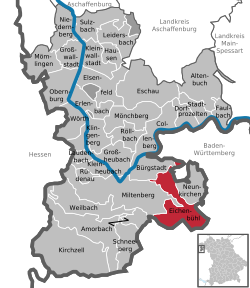Eichenbühl
| Eichenbühl | ||
|---|---|---|
|
||
| Coordinates: 49°42′N 9°20′E / 49.700°N 9.333°ECoordinates: 49°42′N 9°20′E / 49.700°N 9.333°E | ||
| Country | Germany | |
| State | Bavaria | |
| Admin. region | Unterfranken | |
| District | Miltenberg | |
| Government | ||
| • Mayor | Günther Winkler (CSU) | |
| Area | ||
| • Total | 31.24 km2 (12.06 sq mi) | |
| Elevation | 158 m (518 ft) | |
| Population (2016-12-31) | ||
| • Total | 2,514 | |
| • Density | 80/km2 (210/sq mi) | |
| Time zone | CET/CEST (UTC+1/+2) | |
| Postal codes | 63928, 97896 (Ebenheiderhof) | |
| Dialling codes | 09371 | |
| Vehicle registration | MIL | |
| Website | www.eichenbuehl.de | |
Eichenbühl is a community in the Miltenberg district in the Regierungsbezirk of Lower Franconia (Unterfranken) in Bavaria, Germany.
Eichenbühl lies in the Bavarian Lower Main (Bayerischer Untermain) Region.
Eichenbühl’s Ortsteile are Eichenbühl, Guggenberg, Heppdiel, Pfohlbach, Riedern and Windischbuchen.
From the outlying centre of Riedern came the like-named noble family of Riedern whose armorial bearing was a red pot, which is still a charge in the community’s coat of arms today. The community in the Archbishopric of Mainz was awarded in the 1803 Reichsdeputationshauptschluss to the Principality of Leiningen, then mediatized by Baden, and in 1810 ceded to the Grand Duchy of Hesse-Darmstadt. In the Hesse-Bavaria Rezeß in Frankfurt in 1816, it finally passed to Bavaria. In the course of administrative reform in Bavaria, the current community came into being with the Gemeindeedikt (“Municipal Edict”) of 1818.
Within town limits, 2,553 inhabitants were counted in 1970, 2,680 in 1987, in 2000 2,809 and in 2013 2,572.
The mayor is Günther Winkler (CSU).
The council is made up of 14 council members, with the seats apportioned thus:
The community’s arms might be described thus: Per saltire in chief gules a wheel spoked of six argent, dexter argent a pot of the first with two spouts, sinister a flag, the pole of the first per bend sinister, the flag square of the first to sinister of the pole, thereon a cross bottonnée of the field, in base gules issuant from the base point palewise an oak sprig leafed of two and acorned of three of the second.
The six-spoked Wheel of Mainz and the tinctures argent and gules (silver and red) refer to Electoral Mainz’s former overlordship. The red pot is taken from the arms formerly borne by the Lords of Riedern, who were first mentioned in 1206, and who died out in 1588. The flag stands for Heppdiel, the cross thereon being Saint Maurice’s cross, referring to Saint Maurice’s Parish Church in Heppdiel. The oak sprig is canting for the name Eichenbühl (Eiche means “oak” in German), and was drawn from Eichenbühl’s old arms, disgarded in 1959.
...
Wikipedia



